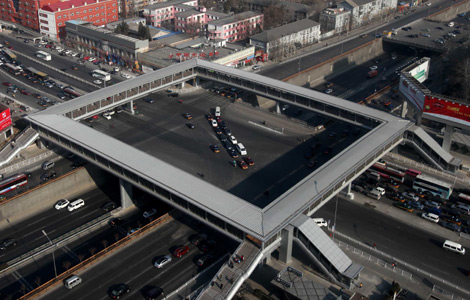Arid capital to get water from key project
Updated: 2012-01-14 07:35
By Jin Zhu (China Daily)
|
|||||||||
NANJING - A large part of Beijing's water will be supplied by the middle route of the South-to-North Water Diversion (SNWD) project when it is completed in 2014 as part of the major efforts to relieve the thirsty capital, officials said.
The project will transfer at least 1 billion cubic meters of water to Beijing a year, accounting for one-fourth of the city's annual water supply, said Sun Guosheng, director of the Beijing branch of the SNWD project office, under the State Council.
At present, Beijing needs about 3.6 billion cubic meters of water a year. That will increase to 4 to 5 billion cubic meters by 2020 as economic growth continues to surge, Sun told China Daily on Wednesday during a three-day work conference in Nanjing, Jiangsu province.
Partly because of consecutive years of drought, the volume of Miyun reservoir, the city's major source of surface water, has stayed at 1.1 billion cubic meters, according to the Beijing Water Authority.
The average depth of groundwater in Beijing is at 25 meters now, significantly lower than 12 meters in 1999, due to years of overuse, according to the water authority.
"Without the extra water brought from outside, the city has certainly suffered from severe water shortages in recent years," he said.
Since 2008, the Beijing-Shijiazhuang section of the middle route of the SNWD project, linking reservoirs in Hebei with Beijing, began supplying water as an emergency measure to help ease the shortage in the capital.
By the end of 2011, up to 1.1 billion cubic meters of water had been transferred to the city, according to the SNWD project office.
"The quality of the diverted water is Grade 2, which is drinkable after treatment. All of that water has been supplied to residences," Sun said.
The SNWD project will divert water from the Yangtze River in the south via an eastern, middle and western route to satisfy the water demand in the arid northern regions of China.
The eastern route will transfer water from East China's Jiangsu province along the Yangtze River to Tianjin, near Beijing, starting in 2013.
The middle route will supply water from the Danjiangkou Reservoir in Central China's Hubei province into large cities including Beijing, Tianjin, Shijiazhuang and Zhengzhou, in 2014.
By the end of 2011, 330,000 people in Henan and Hubei province had to be relocated to make way for the central route, according to the SNWD project office.
"The remaining 15,000 people will be resettled in the first half of this year, which will complete the relocations," E Jingping, head of the SNWD project office, said at the conference.
More than 64 billion yuan ($10.13 billion) will be invested in the water diversion project this year as it goes into high gear, he said.
China invested 57.8 billion yuan in the project in 2011, bringing the total investment to 137.6 billion yuan so far, official figures showed.
Experts with E's office said the western route, meant to replenish the Yellow River with water diverted from the upper reaches of the Yangtze River, now is still at the blueprint stage.
Hot Topics
Kim Jong-il, Mengniu, train crash probe, Vaclav Havel, New Year, coast guard death, Internet security, Mekong River, Strait of Hormuz, economic work conference
Editor's Picks

|

|

|

|

|

|







